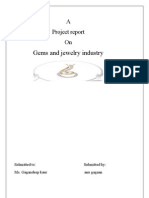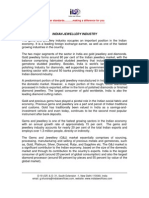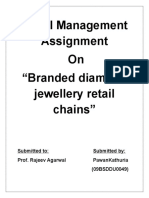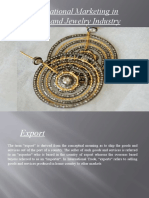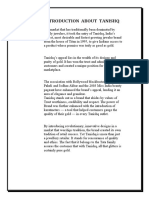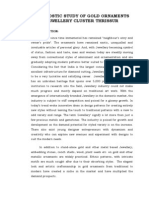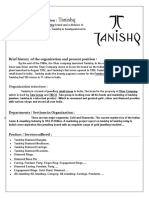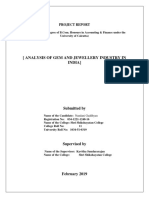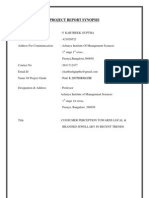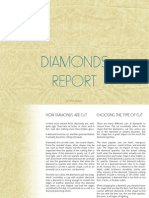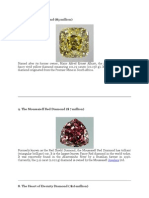Indian Gems and Jewellery Industry
Indian Gems and Jewellery Industry
Uploaded by
Abhishek JhaCopyright:
Available Formats
Indian Gems and Jewellery Industry
Indian Gems and Jewellery Industry
Uploaded by
Abhishek JhaOriginal Title
Copyright
Available Formats
Share this document
Did you find this document useful?
Is this content inappropriate?
Copyright:
Available Formats
Indian Gems and Jewellery Industry
Indian Gems and Jewellery Industry
Uploaded by
Abhishek JhaCopyright:
Available Formats
INDIAN GEMS AND JEWELLERY INDUSTRY
GEMS AND JEWELS SCENARIO
In ancient times people made jewelry out of natural materials like
seeds, feathers, leaves, berries, fruits, flowers, animal bones, claws
and teeth.
The early people made jewelry not only for humans but also for the
gods and decorating animals like elephants and horses, on special
occasions.
It is interesting to note that both men and women of ancient times
wore jewelry made of gold, silver, copper, ivory and precious and
semi-precious stones.
We find the description of jewelry in the great epics, the Ramayana
and the Mahabharata and also in the code of Manu that defines
various duties of the goldsmith.
As a result of this old tradition India has been a leading exporter of
gemstones and manufactured jewelry.
INDIAN SCENARIO
Till 1725, India was the only producer of diamonds in the world.
India has a long history of diamond mining and several diamonds,
including the Kohinoor.
The Golconda mines were world-famous and even today, a Golconda
diamond fetches a very high price in the international market.
Today diamonds are mined only at Panna in the Indian state of
Madhya Pradesh and in Andhra Pradesh by the National Mining
Development Corporation.
India does not contribute much to the world market in terms of rough
diamonds.
India is already the largest diamond cutting and polishing centre in the
world.
The Indian diamond cutting and polishing industry enjoys 60 per cent
value share, 82 per cent carat share and 95 per cent share of the world
market in terms of number of pieces.
Nearly 9 out of 10 diamonds sold worldwide are cut and polished in
India.
Large market for Gems & Jewellery with domestic sales of over $10
billion.
4% of the global Gems and Jewellery market .
Exports of over $15.5 billion; over 18% of India’s exports.
PRODUCTION CENTRES
RAJASTHAN – JAIPUR, POLISHING PRECIOUS AND SEMI
PRECIOUS STONES
GUJARAT –SURAT, DIAMOND PROCESSING CENTRE
MAHARASHTRA-MUMBAI, MACHINE MADE JEWELLERY
TAMIL NADU – TRICHUR, GOLD JEWELLERY AND DIAMOND
CUTTING
DELHI- SILVER JEWELLERY AND ARTICLES
WEST BENGAL-KOLKATA,LIGHTWEIGHT PLAIN GOLD
JEWELLERY
ANDHRA PRADESH-HYDERABAD,PRECIOUS AND SEMI
PRECIOUS STUDDED JEWELLERY
ANDHRA PRADESH-NELLORE,CAPTIVE SOURCEFOR HAND
MADE JEWELLERY.
DOMESTIC INDUSTRY (GOLD)
• From historic times, gold has played a pivotal role in the Indian social
fabric.
• Gold jewellery is very popular among farmers, with an upsurge in
gold sales after a good agricultural season.
• Buying of gold is an important part of every stage of an Indian
citizen's life-at birth, marriage, construction of home, festivals,
religious ceremonies, setting up of new business, and death.
• India is the largest consumer of gold in the world.
• India is also estimated to hold nearly 14,000 tones of gold, accounting
for 9% of the world's cumulative mine production of around 153,000
tones.
DOMESTIC INDUSTRY (DIAMOND)
• The Indian domestic diamond jewellery market is estimated at around
Rs. 80 billion per annum in retail value.
• Because of increased disposable income and aggressive promotion
strategies by the diamond industry, Indian diamond jewellery demand
has increased significantly.
• Nearly 9 out of 10 diamonds sold worldwide are cut and polished in
India.
Destination-wise Exports of Cut and Polished Diamonds
HONG KONG is the largest importer of Indian Cut and Polished Diamond
worth USD 5,484.68 MILLION in 2009-10.
UAE is the second largest importer with USD 5,340.13 MILLION in 2009-
10.
US is the third largest importer with USD 3,183.07 MILLION in 2009-10.
It is followed by Belgium, Israel, Singapore, Japan, Thailand and
Switzerland with USD 1561,739,339,217,265 and 65 millions respectively
in the year 2009-10.
Source-wise Imports of Cut and Polished Diamonds
India imports most of the cut and polished diamond from Belgium. In 2009-
10, the worth was USD 4,556 million.
It is followed by UAE with USD 5,504 million in 2009-10.
Hong kong comes third with USD 2,930 million in 2009-10.
Then comes UK with USD 792 million in 2009-10.
Israel is next with USD 667 million in 2009-10.
Platinum Jewellery
• India's share in the global platinum Jewellery market is growing by 19
per cent annually, it continues to be less than one per cent in the
global platinum Jewellery market.
• As per the Platinum Guild International (India), the number of outlets
selling platinum Jewellery increased from 12 in 2000-01 to over 300
currently. It is predicted that the number of outlets selling platinum
Jewellery would increase to around 1,000 outlets in the next 2-3 years.
Jewellery
• The Indian jewellery market is one of the largest in the world, with a
market size of $13 billion. It is second only to the US market of $ 40
billion and is followed by China at $11 billion.
• The gold jewellery market is growing at 15 per cent per annum and
the diamond jewellery market at 27 per cent per annum.
• The current global costume Jewellery and accessories market is
estimated at US$ 16.3 billion, of which India only exports around
US$ 53 million, thereby, providing a huge opportunity area for the
Indian costume manufacturers.
• The branded jewellery market in India is estimated at $111.6 million
per annum
TOP 10 EXPORT DESTINATIONS OF INDIAN
GEMS & JEWELLERY
The largest exporter of Indian Gems and Jewellery is UAE with export
worth USD 12,524 million in 2009.
Hong kong follow UAE with export worth USD 6,253 million in 2009.
USA is the third largest exporter with USD 4,740 million in 2009.
Belgium follows USA with USD 1,645 million in 2009.
It is followed by countries like Israel, Thailand, China, UK and Japan with
worth USD 753,597,434,349 and 255 million in 2009.
The 10 major players in Indian Gems and Jewellery
Segment
1)FLAWLESS DIAMOND (INDIA) LIMITED
2)GITANJALI GEMS LIMITED
3)GOLKUNDA DIAMOND AND JEWELLERY LIMITED
4) RAJESH EXPORT LIMITED
5)SHENTIVIJAY JEWELS LIMITED
6)SHRENUJ & COMPANY LIMITED
7)SHYAM STARGEMS LIMITED
8)SU-RAJ DIAMONDSAND JEWELLERY LIMITED
9)VAIBHAV GEMS LIMITED
10)WHITE DIAMOND INDUSTRIES LIMITED
Highlights of New Foreign Trade Policy for the year
2009-2014 with respect to Gems & Jewellery Sector
Import of gold of 8 kg and above is allowed under replenishment scheme
subject to import being accompanied by an Assay Certificate specifying
Purity, weight and alloy content.
Duty Free Import Entitlement (based on FOB value of exports during
previous financial year) of Consumables and Tools, for:
Jewellery made out of:
Precious metals (other than Gold & Platinum)– 2%
Gold and Platinum – 1%
Rhodium finished Silver – 3%
Cut and Polished Diamonds – 1%
• Duty free import entitlement of commercial samples shall be Rs.
300,000.
• Duty free re-import entitlement for rejected jewellery shall be 2% of
FOB value of exports.
• Import of Diamonds on consignment basis for Certification/ Grading
& re-export by the authorized offices/agencies of Gemmological
Institute of America (GIA) in India or other approved agencies will be
permitted.
• Personal carriage of Gems & Jewellery products in case of
holding/participating in overseas exhibitions increased to US$ 5
million and to US$ 1 million in case of export promotion tours.
• Extension in number of days for re-import of unsold items in case of
participation in an exhibition in USA increased to 90 days.
• In an endeavour to make India a diamond international trading hub, it
is planned to establish “Diamond Bourse (s)”.
• With an objective to meet the Dollar Credit needs of exporters, a
Committee has been constituted with Finance Secretary, Commerce
Advance Authorizations necessitate exports with a
• minimum value addition of
• Item of Export Minimum Value
Addition
• Plain gold / platinum / silver jewellery and 3%
• Articles and ornaments like Mangalsutra
• containing gold and black beads / imitation
• stones, except in studded form of jewellery.
• All types of Studded gold / platinum / silver 5%
• Jewellery and articles thereof.
• Any jewellery / articles manufactured by fully 1.5%
• mechanised process
• Gold / silver / platinum medallions & coins 1.5%
• (excluding coins of nature of legal tender)
• Gold / silver / platinum findings / mountings 2.25%
• manufactured by mechanised process
SEZs in Gems and JewellerySector
• Santacruz Electronics Export Processing Zone (SEEPZ)
• Manikanchan SEZ, W. Bengal
• Jaipur SEZ
• Surat Special Economic Zone
• Surat in Gujarat, which is home to thousands of diamond units with
lakhs of diamond workers, has been recognized as “Town of Export
Excellence”.
QUALITY STANDARDS
The Bureau of Indian Standards has launched its hallmarking scheme.
Hallmarking is the benchmark regarding the purity of input used in the
product.
The various other institute facilitating GEMS AND JEWELLERY are:
• G.I.A. - Gemological Institute Of America
• A.G.S. - American Gem Society
• E.G.L. - European Gemological Laboratory
• I.G.I. - International Gemological Institute
Quick Gold Hallmark Guide
.999 = 24 carat = 99.9%
.916 = 22 carat = 91.6%
.750 = 18 carat = 75%
.585 = 14 carat = 58.5%
.375 = 9 carat = 37.5%
The hallmark is only applied after the item has been assayed to determine
that its purity conforms not only to the standards set down by the law but
also and with the maker’s claims as to metallurgical content.
KEY ISSUES FOR THE SECTOR
Large Presence of Unorganized Sector
The bulk of the GJ industry in India is concentrated in the
unorganized sector and employs around 2 million workers serving
over 0.1 million gold jewellers and over 8,000 diamond jewellers.
The centre of India's GJ industry is Mumbai. Most imports of
gold and rough diamond arrives in Mumbai. However, most of
the processing of diamonds takes place in the neighboring state
of Gujarat, mostly in Surat, Bhavnagar, Ahmedabad, Bhuj, and
Navasari.
Laser technology was introduced in the early-1990s for
operations like cleaving and sawing. More than 500 such
machines are estimated to be in operation in India, thereby
enhancing production efficiency and quality.
Indian companies are now venturing into processing of larger
and expensive stones. While incredibly precise, computerized
machinery is now used in some parts of the cutting process for
some diamonds, most of the work is still performed by hand
using exacting and meticulous techniques.
Limited Potential for Greater Value Addition in Gold
Jewellery
In India, jewellery consumption is primarily of gold.
Gold jewellery is fabricated mainly in 22-carat gold and, lower
carat age is not favored as the Indian mindset does not accept
low purity gold jewellery.
The bargaining power of the buyer is typically limited to the
fabrication charges.
A jeweler or goldsmith of reasonable standing in a local area
has a fixed and loyal clientele.
The system of hallmarking is expected to increase the buyer's
confidence in the jewellery's purity.
Hallmarking of gold is mandatory from January 1, 2008.
Possible Long-term threat from China
Although India currently enjoys dominance in the world's cut
and polished diamonds market, China may emerge as a viable
rival, if not in the near term, certainly in the longer term.
An increasing number of diamond processors from Israel and
Belgium, and even India, are setting up facilities in China, for a
variety of reasons:
The labor force, like in India, is cheap and disciplined;
High economic growth over the past decade has resulted
in a significant increase in potential consumers in the
high-income segment within the country; by comparison,
India has to rely almost solely on exports;
Quality of Chinese workmanship is steadily improving.
China has rapidly become the world's second largest diamond
manufacturing centre, when measured in manpower terms.
Technology is another area where the Indian industry faces a
long-term threat from China.
China with its modern and automatic factories is today in a
similar position to manufacture jewellery at competitive prices.
Threat from Polishing in Producing Nations
There has been increased political pressure by major diamond
producing countries in Africa-Botswana, Angola, Namibia and
South Africa-to gain further economic benefits from diamond
production through jobs creation in a domestic cutting and
polishing industry.
Most of these countries have no history of diamond polishing
but the skills can be taught as has been seen by the recent rapid
growth of jobs in other non-traditional centers such as the Far
East and Armenia.
The pressure towards polishing in the producing countries is
growing and increasingly it is a part of the overall agreement
permitting mining, or of not imposing high taxes.
The Indian diamond industry has thrived because for economic
reasons, most smaller stones cannot be profitably cut in higher
cost locations.
You might also like
- Project Report On Gems and Jewelry IndustryDocument61 pagesProject Report On Gems and Jewelry IndustryAmy Sharma53% (15)
- Jwellry Sip ProjectDocument60 pagesJwellry Sip Project153KAPIL RANKANo ratings yet
- Shifts That Occurred in The Natural Diamonds Industry?Document7 pagesShifts That Occurred in The Natural Diamonds Industry?Devanshi GuptaNo ratings yet
- Swot Analysis On Diamond Cutting IndustriesDocument13 pagesSwot Analysis On Diamond Cutting IndustriesPawan2183% (6)
- Project Report On Gold Jewellery Casting FactoryDocument10 pagesProject Report On Gold Jewellery Casting FactorySachin SharmaNo ratings yet
- Tanishq Brand AnalysisDocument32 pagesTanishq Brand AnalysisPrathama Deokar100% (2)
- Indian Jewellery Industry: Prepared by Submitted ToDocument20 pagesIndian Jewellery Industry: Prepared by Submitted Tomanisha92% (13)
- Pestal Analysis and Porters' Five Force Model On Diamond IndustryDocument15 pagesPestal Analysis and Porters' Five Force Model On Diamond Industrysanni patel0% (2)
- Technological: 3. PESTEL AnalysisDocument4 pagesTechnological: 3. PESTEL AnalysisShruti GargNo ratings yet
- De Beers, Marketing Diamonds To MillennialsDocument13 pagesDe Beers, Marketing Diamonds To MillennialsNitish100% (1)
- Jewellery MarketDocument13 pagesJewellery MarketPrathish JosephNo ratings yet
- (PDF) Gems & - Jewellery FinalDocument23 pages(PDF) Gems & - Jewellery FinalRohan JoshiNo ratings yet
- An Analysis of The Gems & Jewellery Industry in IndiaDocument43 pagesAn Analysis of The Gems & Jewellery Industry in IndiaRanjeet Ramaswamy Iyer100% (4)
- Industry and Company Profile 2Document5 pagesIndustry and Company Profile 2Ziyad AktharNo ratings yet
- Pranav Jewellery ReportDocument59 pagesPranav Jewellery ReportAkash KapoorNo ratings yet
- A Study On Jewellery Industry in Tamil Nadu: November 2019Document38 pagesA Study On Jewellery Industry in Tamil Nadu: November 2019Sreelatha ChakravarthulaNo ratings yet
- Case Study On Jewellery IndustryDocument62 pagesCase Study On Jewellery Industrysaloni67% (3)
- INTERSHIP REPORT SharooqDocument24 pagesINTERSHIP REPORT SharooqSagar K SNo ratings yet
- On Gems and JewelaryDocument32 pagesOn Gems and Jewelarydeepikakeerthichilkuri100% (1)
- Group5 - Jewellery Buying BehaviourDocument12 pagesGroup5 - Jewellery Buying BehaviourGopinath GovindarajNo ratings yet
- Project Report On Gems and Jewelry IndustryDocument61 pagesProject Report On Gems and Jewelry IndustrylakshitaNo ratings yet
- Retail Management Assignment On "Branded Diamond Jewellery Retail Chains"Document8 pagesRetail Management Assignment On "Branded Diamond Jewellery Retail Chains"Pawan VintuNo ratings yet
- Diamond Ring Buying Guide: How to Identify, Evaluate & Select The Best Diamonds & Diamond Jewelry, 8th EditionFrom EverandDiamond Ring Buying Guide: How to Identify, Evaluate & Select The Best Diamonds & Diamond Jewelry, 8th EditionRating: 1 out of 5 stars1/5 (1)
- Case Study On Gitanjali GemsDocument25 pagesCase Study On Gitanjali Gemsvinay1805No ratings yet
- Gems Jewellery SectorDocument16 pagesGems Jewellery Sectorjagriti singhNo ratings yet
- Positioning To Capture The Indian Women's Heart: Submitted by Meghna Peethambaran K07033Document12 pagesPositioning To Capture The Indian Women's Heart: Submitted by Meghna Peethambaran K07033meghna0% (1)
- Dharnish ReportDocument13 pagesDharnish Reportdarshan75% (4)
- Gems and Jewelry Industry: International Marketing inDocument13 pagesGems and Jewelry Industry: International Marketing inshilpichakravartyNo ratings yet
- A Marketing Project Report On Tanishq - 76955260Document12 pagesA Marketing Project Report On Tanishq - 76955260afra anjum nadafNo ratings yet
- Final Tanishq Marketing StrategyDocument36 pagesFinal Tanishq Marketing StrategyBalwant OjhaNo ratings yet
- Gems and Jewellery Final Project ReportDocument12 pagesGems and Jewellery Final Project Reportapi-371236771% (17)
- Diagnostic Study Report of Gold Ornaments Jewellary Cluster - ThrissurDocument45 pagesDiagnostic Study Report of Gold Ornaments Jewellary Cluster - ThrissurAditya Razdan100% (1)
- Summer Internship Project On Jewellery IndustryDocument8 pagesSummer Internship Project On Jewellery Industryneha100% (2)
- TANISHQ - Group 1 Corporate Communication M5th BatchDocument26 pagesTANISHQ - Group 1 Corporate Communication M5th BatchMausam SharmaNo ratings yet
- Profile of Jewellery IndustryDocument71 pagesProfile of Jewellery IndustryFebinBaby GodisgoodNo ratings yet
- Unique Selling Proposition (Importance of USP For Jewellers)Document26 pagesUnique Selling Proposition (Importance of USP For Jewellers)Raghu.G100% (1)
- Tanishq Visual MerchandisingDocument5 pagesTanishq Visual MerchandisingAnkit MehtaNo ratings yet
- Tanishq: Introduction To OrganizationDocument2 pagesTanishq: Introduction To OrganizationSuraj DeshmukhNo ratings yet
- An Analysis of India'S Gems and Jewellery Sector: Submitted By: Atishay Jain Section - F Roll No. - 16 CertificateDocument26 pagesAn Analysis of India'S Gems and Jewellery Sector: Submitted By: Atishay Jain Section - F Roll No. - 16 CertificatecoolatishayNo ratings yet
- A Study On The Effect of Imitation Jewellery On Real Sales of Gold JewelleryDocument6 pagesA Study On The Effect of Imitation Jewellery On Real Sales of Gold JewelleryarcherselevatorsNo ratings yet
- Diamond Cutting IndustriesDocument54 pagesDiamond Cutting IndustriesPawan2133% (3)
- Diamond Jewellery IndustryDocument122 pagesDiamond Jewellery IndustryShweta ChaughuleNo ratings yet
- Tanishq Vs GiliDocument21 pagesTanishq Vs Giliblue_devil8132409No ratings yet
- TANISHQDocument3 pagesTANISHQPrabhat Singh100% (1)
- Customer Perception Towards Branded Jewelry in IndiaDocument46 pagesCustomer Perception Towards Branded Jewelry in Indiaalkanm750100% (1)
- Mia by Tanishq - Brand and Indepth Study - RevisedDocument47 pagesMia by Tanishq - Brand and Indepth Study - Revisedmahima100% (1)
- Gems and Jewellery Industry Analysis: Brief HistoryDocument4 pagesGems and Jewellery Industry Analysis: Brief HistoryPrakash Bhushan100% (2)
- OrraDocument13 pagesOrraShubhi JainNo ratings yet
- A Study On Consumer Changing Buying Behaviour From Gold Jewellery To Diamond JewelleryDocument9 pagesA Study On Consumer Changing Buying Behaviour From Gold Jewellery To Diamond JewellerynehaNo ratings yet
- Indian Diamond IndustryDocument44 pagesIndian Diamond IndustryPalak KathuriaNo ratings yet
- Market Review For Tanishq... : Click To Edit Master Subtitle StyleDocument13 pagesMarket Review For Tanishq... : Click To Edit Master Subtitle StyleRishabh DugarNo ratings yet
- Gems and JewelleryDocument27 pagesGems and JewelleryAkash MehtaNo ratings yet
- A Project Report On Opening Up of A JeweDocument48 pagesA Project Report On Opening Up of A Jewetehseen ahmedNo ratings yet
- JewelsDocument28 pagesJewelsNilesh VariaNo ratings yet
- Tanishq JewellersDocument54 pagesTanishq JewellersAssassin129580% (5)
- Consumer Perception Towards Local & Branded Jewellary in Recent TrendsDocument4 pagesConsumer Perception Towards Local & Branded Jewellary in Recent TrendsYkartheek Guptha100% (1)
- Indian Jewellry IndustryDocument30 pagesIndian Jewellry Industryarnabnitw100% (1)
- A Gem in India's Crown: Group No. 03Document46 pagesA Gem in India's Crown: Group No. 03NEHRA HIMANSHINo ratings yet
- Jewellery ReportDocument60 pagesJewellery ReportRhaeya RajNo ratings yet
- Indian Jewelry IndustryDocument28 pagesIndian Jewelry IndustryAkbar KamalNo ratings yet
- Unbranded Gold Research in BelgaumDocument40 pagesUnbranded Gold Research in BelgaumkumarashivashivaNo ratings yet
- Exploration Under Total Cover: A Case Study From Northwest BotswanaDocument15 pagesExploration Under Total Cover: A Case Study From Northwest BotswanaPumulo MukubeNo ratings yet
- Rapaport 2017Document2 pagesRapaport 2017Juan Antonio Vega CatapanoNo ratings yet
- GemsDocument92 pagesGemssaopauloNo ratings yet
- Group 7 - SCM Assignment 2Document14 pagesGroup 7 - SCM Assignment 2Rahul DattaNo ratings yet
- Guide To Rock Hunting and ProspectingDocument32 pagesGuide To Rock Hunting and ProspectingNoone Uneedtono100% (2)
- Diamonds ReportDocument7 pagesDiamonds ReportUsertightNo ratings yet
- SolitaireDocument17 pagesSolitaireinsurancekatariaNo ratings yet
- Diamond Certification - The Complete GuideDocument1 pageDiamond Certification - The Complete GuideFungai Emmanuel BoteNo ratings yet
- Stihl Gs 461: Instruction ManualDocument36 pagesStihl Gs 461: Instruction ManualKevin HowardNo ratings yet
- PagesDocument90 pagesPagesSii Danny100% (1)
- The Allnatt Diamond ($3 Million) : JewelersDocument5 pagesThe Allnatt Diamond ($3 Million) : JewelersTomi TodinganNo ratings yet
- Effective Use of Gems in AstrologyDocument3 pagesEffective Use of Gems in Astrologyabhi16No ratings yet
- GEO 151S LESSON NOTE 3 (MINERALOGY Part A)Document22 pagesGEO 151S LESSON NOTE 3 (MINERALOGY Part A)Oluseyi AbegundeNo ratings yet
- Scope of Indian Gems and Jewellery Market in InternationalDocument17 pagesScope of Indian Gems and Jewellery Market in InternationalNIKHILPATNINo ratings yet
- Igi CertificationDocument1 pageIgi CertificationGauravNo ratings yet
- SMost Repeated Questions of Carbon and It's CompundDocument7 pagesSMost Repeated Questions of Carbon and It's Compundanshchauhan012345No ratings yet
- Castillo Oliver2017Document64 pagesCastillo Oliver2017Sahroz KhanNo ratings yet
- VAR 3486 - PDC UpdatedMay2014 v1.0 SM PDFDocument32 pagesVAR 3486 - PDC UpdatedMay2014 v1.0 SM PDFpendexxNo ratings yet
- Discover The Diamond in YouDocument60 pagesDiscover The Diamond in YougsuryasanjaiNo ratings yet
- MineralsDocument2 pagesMineralsapi-442385471100% (1)
- Chapter 5 Rotary Drilling BitsDocument13 pagesChapter 5 Rotary Drilling BitsMAX99 FMNo ratings yet
- Catálogo en Inglés PDFDocument76 pagesCatálogo en Inglés PDFBlue FairylandNo ratings yet
- Ivey Harikrishna..Document10 pagesIvey Harikrishna..AchyutNo ratings yet
- SAMPLE LESSON PLAN FOR 5es IN TEACHING SCIENCE PDFDocument4 pagesSAMPLE LESSON PLAN FOR 5es IN TEACHING SCIENCE PDFMia AstilloNo ratings yet
- National Fire Protection Association-GoogleDocument2 pagesNational Fire Protection Association-GooglesandeepNo ratings yet
- An Update On Color in Gems - Part 2 - Gems & Gemology SP88A1Document13 pagesAn Update On Color in Gems - Part 2 - Gems & Gemology SP88A1MickShazan100% (1)
- PSI Superfinishing 2012 CatalogDocument52 pagesPSI Superfinishing 2012 CatalogjhscribdaccNo ratings yet
- Geotechnical Aspects of Open Stope Design at BHP Cannington: G C StreetonDocument7 pagesGeotechnical Aspects of Open Stope Design at BHP Cannington: G C StreetonJuan PerezNo ratings yet
